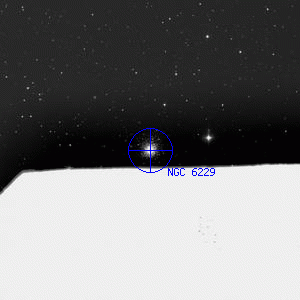NGC 6229

Overlaid DSS image of NGC 6229, 30' x 30' with north at top and west to the right
Aladin viewer for the region around NGC 6229
| Type | Globular Cluster |
|---|---|
| Magnitude | 9.4 |
| Size | 4.5' |
| Right Ascension | 16h 46' 58.8" (2000) |
| Declination | 47° 31' 40" N |
| Constellation | Hercules |
| Description | vB, L, R, disc, r |
| Classification | IV |
Observing Notes
Andrew Cooper
Apr 29, 2023 Waikoloa, HI (map)
20cm f/6 Newtonian, Cave Astrola @ 153x
Seeing: 7 Transparency: 6 Moon: 0%
Small, faint, 3' diameter, round, not resolved, both Smyth and Webb call this globular cluster a planetary nebula, it does resist resolving with smaller instruments even with higher magnification, only with the 18" have I resolved this cluster
Andrew Cooper
Jul 13, 2020 Waikoloa, HI (map)
20cm f/6 Newtonian, Cave Astrola @ 47x
Seeing: 6 Transparency: 5 Moon: 0%
Faint, small, a dense core, not resolved, a pair of 8th magnitude stars 5' west of the cluster
Andrew Cooper
May 20, 2001 Jarnac Obs., Vail, AZ (map)
46cm f/4.5 Deep Violet
Small, dense, fully resolved, decent little globular
Rev. T.W. Webb
May 19, 1885 Hardwick, Herefordshire, England (map)
94mm f/18 Tully Achromat
Planetary nebula, faint with 3-7/10 in., but beautifully grouped in a triangle with two 6 mg. stars. D'A., very crowded cluster.― Celestial Objects for Common Telescopes, T. W. Webb, 1917
Captain William Henry Smyth
May 1, 1835 No. 6 The Crescent, Bedford, England (map)
150mm f/17.6 refractor by Tully 1827
A fine planetary nebula, between the left heel and the right knee of Hercules; the mean apparent place of which was carefully differentiated from τ Herculis; from which it bears east-by-north, 4° distant, and from γ Draconis west-south-west, about 10°. This object, which was discovered in May, 1787, is large, round, and of a lucid pale-blue hue; but its definition and distinctness are encroached upon by the brilliance of the 6th-magnitude stars near it; one of which precedes the nebula by 22s, nearly on the parallel. It was offered as a "prize comet" to Maria Louisa of Lucca, in 1819; and the dénouement made by Baron de Zach, led to the appointment of M. Pons as her Majesty's astroscoper in the new observatory at La Marlia, where he was to receive 100 dollars for every comet that might be discovered. But the establishment, though commenced under considerable pomp and circumstance, only lingered about four years, and was then formally abolished. This is one of the mortifying instances, wherein the poverty of a queen's treasury prevented her manifesting that reverence for science, which she really felt.― A Cycle of Celestial Objects Vol II, The Bedford Catalogue, William Henry Smyth, 1844
Other Data Sources for NGC 6229
Nearby objects for NGC 6229
4 objects found within 120'
| 52 Herculis | HD 152812 | |
| IC 1232 |
Credits...
Drawings, descriptions, and CCD photos are copyright Andrew Cooper unless otherwise noted, no usage without permission.
A complete list of credits and sources can be found on the about page
NGC 6229